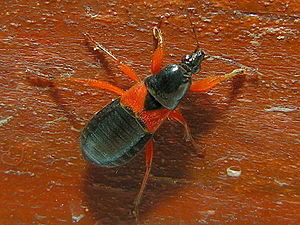Prostemma guttula
| Prostemma guttula | ||||||||||||
|---|---|---|---|---|---|---|---|---|---|---|---|---|

Prostemma guttula |
||||||||||||
| Systematics | ||||||||||||
|
||||||||||||
| Scientific name | ||||||||||||
| Prostemma guttula | ||||||||||||
| ( Fabricius , 1787) |
Prostemma guttula is a species of bug fromthe sickle bug family (Nabidae).
features
The bugs are 7.5 to 10.0 millimeters long. The pronotum of the animals is colored black and often has a blue to greenish metallic sheen. The hemielytras and legs are red. The thighs ( femora ) of the front legs are short and thick. The stink glands are on the back of the abdomen. Both long-winged and short-winged individuals appear.
Occurrence and habitat
The species is the most common of its kind in Central Europe. It occurs from the Mediterranean and Europe, but is absent in Northern Europe. In Germany it is absent in Westphalia, in northern Lower Saxony, in Schleswig-Holstein and in western Mecklenburg-Western Pomerania. In the south of Germany it is not uncommon in many places, but it can also be missing locally. It occurs only sporadically in the north. In Austria they are mainly found in the foothills of the Alps.
Dry, warm sandy or limestone soils with low vegetation are settled.
Way of life
Prostemma guttula feeds exclusively on other bed bugs, predominantly on the adults and nymphs of ground bugs (Lygaeidae) and species of the Pentatomoidea , here in particular earth bugs (Cydnidae). They track their prey based on the characteristic smell of bedbugs from the secretions of the scent glands. This was investigated through experiments with other insects that were provided with these fragrances. When hunting, Prostemma guttula stings its prey mainly in the head area near the base of the trunk. Smaller prey is captured and sucked out directly; Larger prey animals are first released after the sting and pursued until they are still. During the day, the animals hide under stones, rosettes of leaves or in plant cushions.
supporting documents
Individual evidence
- ↑ a b c d Ekkehard Wachmann , Albert Melber, Jürgen Deckert: Bugs. Volume 1: Cimicomorpha: Dipsocoromorpha, Nepomorpha, Gerromorpha, Leptopodomorpha, Cimicomorpha (part 1) (= The animal world of Germany and the adjacent sea parts according to their characteristics and according to their way of life . 77th part). Goecke & Evers, Keltern 2006, ISBN 3-931374-49-1 , p. 160 ff .
- ↑ Frieder Sauer: Sauer's nature guide recognized bugs and cicadas from color photos . Fauna, Keltern 1996, ISBN 3-923010-12-5 , p. 130 .
literature
- Frieder Sauer: Sauer's nature guide recognized bugs and cicadas from color photos . Fauna, Keltern 1996, ISBN 3-923010-12-5 .
- Ekkehard Wachmann , Albert Melber, Jürgen Deckert: Bugs. Volume 1: Cimicomorpha: Dipsocoromorpha, Nepomorpha, Gerromorpha, Leptopodomorpha, Cimicomorpha (part 1) (= The animal world of Germany and the adjacent sea parts according to their characteristics and according to their way of life . 77th part). Goecke & Evers, Keltern 2006, ISBN 3-931374-49-1 .
Web links
- Prostemma guttula in Fauna Europaea. Retrieved December 29, 2015



